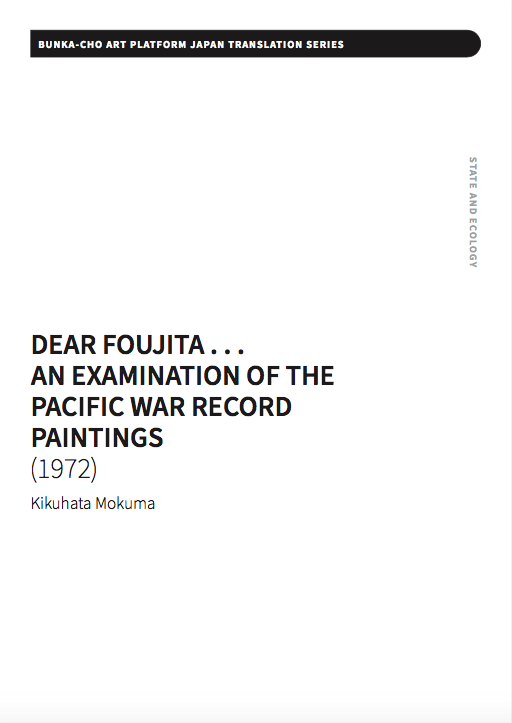Dear Foujita…: An examination of the Pacific War record paintings
Kikuhata Mokuma
R202209

Kikuhata Mokuma (1935-2020), who actively produced work within the Anti-art movement, was known as a key member of the Kyushu-ha artist collective. However, after that, he temporarily distanced himself from artmaking and, as seen in papers like this one, has been considering the problem of sensōga, or war paintings (paintings that serve as records of war). Since the Second Sino-Japanese War, war paintings had been a propaganda project in which many artists participated—most notably Fujita Tsuguharu—producing paintings that treat war as their subject at the behest of the state. After WWII, they were confiscated by the US military, but in 1970 they were returned in the form of a “permanent loan,” and housed in the Museum of Modern Art, Tokyo. This paper was written against the backdrop of the return of such war paintings to Japan.
Kikuhata’s critical concern here reflects his response to the postwar art world’s attempts to confine the place of war paintings to merely an embarrassing episode within Japanese art. By looking back on the circumstances within which Fujita Tsuguharu became involved in the production of war paintings, Kikuhata brings to light the complicated factors—the impossibility of renouncing cooperation with the war effort, the integrity of the work itself, his inferiority complex as a Japanese person living in Paris, etc.—inherent to his war paintings. What Kikuhata turns his attention to are the bloody, ghastly war paintings from the final phase of the war (Defeat Period), and he understands these as having quite a different character from the powerful, propagandistic paintings from Japan’s successful war campaign period (Victory Period). Ultimately, this is a critique of the thoughtless negligence of, and a formal objection to the irresponsibility of, the postwar Japanese art world in charging Fujita alone with responsibility for the war, despite the fact that a whole host of other painters also complied with the regime.
Kikuhata’s thoughts on war paintings are compiled in his Sleep, Fujita: Painting and War (Fujita yo nemure, egaki to sensō) and Art for the Emperor—Modern Thought and War Paintings (Tennō no bijutsu—kindai shisō to sensōga).
- Title
- Dear Foujita…: An examination of the Pacific War record paintings
- Author
- Kikuhata Mokuma
- First published
- 1972
- Translation
- Justin Jesty
- Editing
- Asato Ikeda, Yung-Hsiang Kao
- Design
- Ian Lynam
- Theme
- State and Ecology
- First Posted Online
- 2023-02-09
- Last modified
- 2023-02-09
© 2022 Kikuhata Takuma + Bunka-cho Art Platform Japan
The newly published English translations on this website (https://artplatform.go.jp) can be used without permission only for the purposes of education, research, critique, survey, and the like. English translations cannot be copied for the purpose of sale or distribution. You must comply with the Rules Governing the Use of the English Translations.
- Citation
- Footnote/endnote: Kikuhata Mokuma, "Dear Foujita…: An examination of the Pacific War record paintings," trans. Justin Jesty, Bunka-cho Art Platform Japan, posted February 9, 2023, artplatform.go.jp/readings/R202209.
Bibliography: Kikuhata Mokuma. "Dear Foujita…: An examination of the Pacific War record paintings." Translated by Justin Jesty. Bunka-cho Art Platform Japan. Posted February 9, 2023, artplatform.go.jp/readings/R202209. - Original Japanese Edition
- Kikuhata Mokuma “Fujita yo anata wa…: Taiheiyō Sensō kirokuga kara no kōsatsu” in Bijutsu techō, (March 1972): 174–187.
菊畑茂久馬「フジタよ あなたは…--太平洋戦争記録画からの考察」『美術手帖』(1972年3月)、 174–187頁。 - National Diet Library(NDL)
- ISBN
